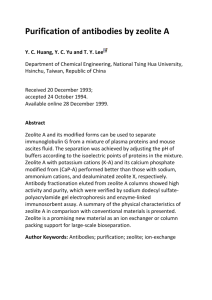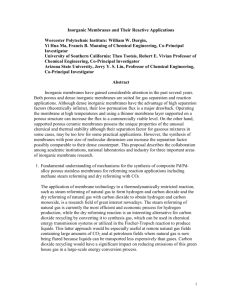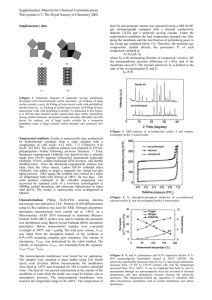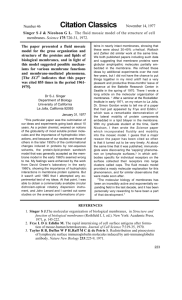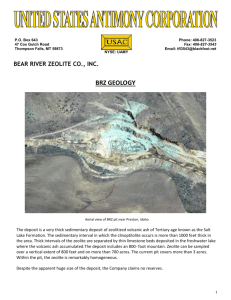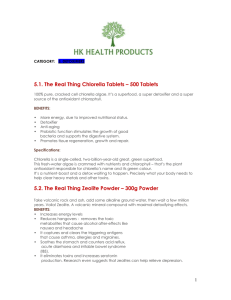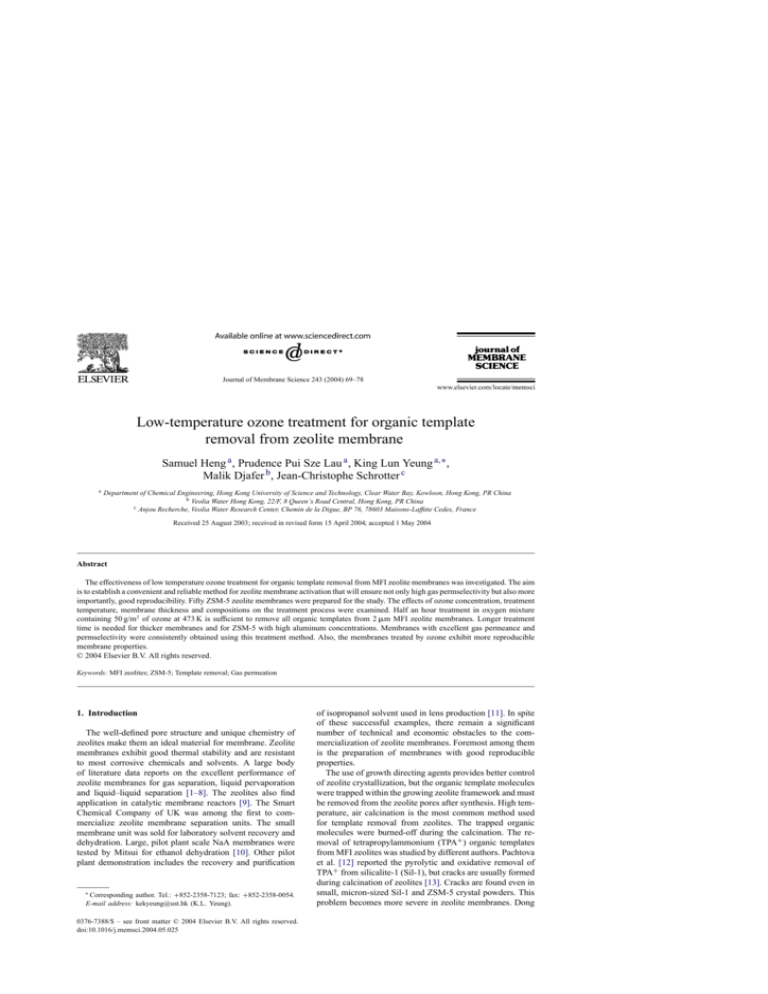
Journal of Membrane Science 243 (2004) 69–78
Low-temperature ozone treatment for organic template
removal from zeolite membrane
Samuel Heng a , Prudence Pui Sze Lau a , King Lun Yeung a,∗ ,
Malik Djafer b , Jean-Christophe Schrotter c
a
Department of Chemical Engineering, Hong Kong University of Science and Technology, Clear Water Bay, Kowloon, Hong Kong, PR China
b Veolia Water Hong Kong, 22/F, 8 Queen’s Road Central, Hong Kong, PR China
c Anjou Recherche, Veolia Water Research Center, Chemin de la Digue, BP 76, 78603 Maisons-Laffitte Cedex, France
Received 25 August 2003; received in revised form 15 April 2004; accepted 1 May 2004
Abstract
The effectiveness of low temperature ozone treatment for organic template removal from MFI zeolite membranes was investigated. The aim
is to establish a convenient and reliable method for zeolite membrane activation that will ensure not only high gas permselectivity but also more
importantly, good reproducibility. Fifty ZSM-5 zeolite membranes were prepared for the study. The effects of ozone concentration, treatment
temperature, membrane thickness and compositions on the treatment process were examined. Half an hour treatment in oxygen mixture
containing 50 g/m3 of ozone at 473 K is sufficient to remove all organic templates from 2 m MFI zeolite membranes. Longer treatment
time is needed for thicker membranes and for ZSM-5 with high aluminum concentrations. Membranes with excellent gas permeance and
permselectivity were consistently obtained using this treatment method. Also, the membranes treated by ozone exhibit more reproducible
membrane properties.
© 2004 Elsevier B.V. All rights reserved.
Keywords: MFI zeolites; ZSM-5; Template removal; Gas permeation
1. Introduction
The well-defined pore structure and unique chemistry of
zeolites make them an ideal material for membrane. Zeolite
membranes exhibit good thermal stability and are resistant
to most corrosive chemicals and solvents. A large body
of literature data reports on the excellent performance of
zeolite membranes for gas separation, liquid pervaporation
and liquid–liquid separation [1–8]. The zeolites also find
application in catalytic membrane reactors [9]. The Smart
Chemical Company of UK was among the first to commercialize zeolite membrane separation units. The small
membrane unit was sold for laboratory solvent recovery and
dehydration. Large, pilot plant scale NaA membranes were
tested by Mitsui for ethanol dehydration [10]. Other pilot
plant demonstration includes the recovery and purification
∗
Corresponding author. Tel.: +852-2358-7123; fax: +852-2358-0054.
E-mail address: kekyeung@ust.hk (K.L. Yeung).
0376-7388/$ – see front matter © 2004 Elsevier B.V. All rights reserved.
doi:10.1016/j.memsci.2004.05.025
of isopropanol solvent used in lens production [11]. In spite
of these successful examples, there remain a significant
number of technical and economic obstacles to the commercialization of zeolite membranes. Foremost among them
is the preparation of membranes with good reproducible
properties.
The use of growth directing agents provides better control
of zeolite crystallization, but the organic template molecules
were trapped within the growing zeolite framework and must
be removed from the zeolite pores after synthesis. High temperature, air calcination is the most common method used
for template removal from zeolites. The trapped organic
molecules were burned-off during the calcination. The removal of tetrapropylammonium (TPA+ ) organic templates
from MFI zeolites was studied by different authors. Pachtova
et al. [12] reported the pyrolytic and oxidative removal of
TPA+ from silicalite-1 (Sil-1), but cracks are usually formed
during calcination of zeolites [13]. Cracks are found even in
small, micron-sized Sil-1 and ZSM-5 crystal powders. This
problem becomes more severe in zeolite membranes. Dong
70
S. Heng et al. / Journal of Membrane Science 243 (2004) 69–78
et al. [14] reported that the thermal stresses caused by the
sudden shrinkage in zeolite crystal during template removal
was the main contributing factor to crack formation in supported zeolite membranes. The presence of cracks in membrane usually means poor membrane performance.
Ozone treatment has been employed for reactivation of
zeolite catalyst powders (e.g. TS-1) after their use in reactions [15]. It was described that the removal of coke from
the zeolite pores by ozone was aided by the presence of
active titanium atoms in the zeolite framework. Kiricsi et
al. [16] demonstrated the use of ozone for low temperature
template removal from microporous and mesoporous powders. Gilbert et al. [17] showed that the template removal
from TPA-silicalite-1 powders occurs under milder conditions in air mixture contain ozone compared to other treatment gases (i.e. air, oxygen and helium). X-ray diffraction
analysis showed that at low concentrations, ozone does not
damage the microscopic structure of the zeolites [18]. All
ozone studies to date were for zeolite catalyst powders where
cracks do not affect their reaction performance, therefore no
information was provided about possible crack formation
during ozone treatment.
Although ozone treatment enables template removal at
lower temperatures, this does not a guarantee the absence of
cracks and defects. This work reports the use of low temperature ozone treatment for template removal from MFI zeolite
membranes. The aim is to establish a convenient and reliable
method for membrane activation that will ensure not only
high gas permselectivity but also more importantly, good reproducibility. The effects of ozone concentration, treatment
temperature, membrane thickness and compositions were
investigated. Gas permeation and separation were used to
evaluate the membrane performance. Fifty membranes were
prepared and tested during the course of this study.
2. Experiments
Table 1
Synthesis composition and preparation conditions for zeolite membranes
Synthesis composition
T (K)
Time (h)
(A) 2 m Sil-1 membrane
40 TEOS:10 TPAOH:20000 H2 O
403
18
(B) 8–50 m Sil-1 membrane
80 TEOS:10 TPAOH:20000 H2 O
453
24–200
423
24
(C) 2 m ZSM-5 membrane
40 TEOS:4 Al(OH)3 :1 TPAOH:10
NaOH:20000 H2 O
cause crack formation and delamination of the seed layer.
The seeded tubes were calcined in air at 623 K for 24 h after
further drying in an oven at 333 K for overnight.
The seeded ␣-Al2 O3 tube was wrapped with Teflon tape
to prevent unwanted zeolite deposition on the external surface of the tube, and placed in a Teflon vessel containing
100 ml zeolite synthesis solution. A clear synthesis solution was prepared by hydrolysis of tetraethyl orthosilicate
(TEOS, 98%, Aldrich) and aluminum sulfate (Al2 (SO4 )3 ,
>98%, Aldrich) in an aqueous solution containing sodium
hydroxide (99%, Riedel-de Haën) and tetrapropylammonium hydroxide (TPAOH, 1 M, Aldrich). Three synthesis
compositions were used to grow the Sil-1 and ZSM-5 membranes (Table 1). The Teflon vessel containing the seeded
tube and synthesis solution was sealed in a stainless steel
autoclave and placed in a preheated oven. After synthesis,
the autoclave was rapidly quenched to room temperature
and the zeolite membrane was rinsed with DDI water and
dried overnight in an oven at 333 K. The membrane thickness and microstructure were analyzed by scanning electron
microscopy (SEM, JEOL 6300), while the membrane orientation and phase purity were examined by X-ray diffraction (XRD, Philips PW 1830). The elemental composition
of the membrane was determined by X-ray photoelectron
spectroscopy (XPS, Physical electronics PHI 5600) and energy dispersive X-ray spectroscopy (EDXS, Inca).
2.1. Zeolite membrane synthesis and characterization
2.2. Zeolite membrane activation
Porous ␣-Al2 O3 tubes purchased from US Filters were
chosen as support for the zeolite membranes. The ceramic
support has a graded pore structure with the innermost support layer having a nominal pore size of 0.1 m. The tubes
were cut into 75 mm pieces, rinsed with distilled, deionized
(DDI) water and dried in an oven for overnight at 333 K. The
supports were calcined in a furnace at 823 K for 8 h to stabilize the support and burn-off adsorbed organic contaminants.
The ends of the tube were then sealed with a thin layer of
enamel glaze (Aremco Products) that could withstand temperatures of up to 873 K. The inner surface of the ceramic
tube was seeded with a layer of silicalite-1 nanocrystals by
slip-casting. The 100 nm, silicalite-1 seeds were prepared by
hydrothermal synthesis and purified by a series of centrifugation and washing steps [19]. The slip-casted tubes were
dried overnight in humid air to prevent rapid drying that can
Prior to the template removal, the zeolite membranes were
impermeable to gases (i.e. He and N2 ) indicating an absence
of nonzeolite pores. The TPA+ templates trapped within the
zeolite pores were removed using two methods, air calcinations at elevated temperature (i.e. 823 K) and ozone treatment at low temperature (i.e. 473 K). The calcination and
ozone treatments were conducted in the experimental setup
shown in Fig. 1. The membrane was placed in a stainless
steel housing and a leak-free seal was obtained using O-ring
and special endcap assembly. Rubber and graphite O-rings
were used respectively for low and high temperature treatments. The unit consists of an inlet and an outlet for the
retentate and a single outlet for the permeate stream. Pure
oxygen or oxygen–ozone mixtures were fed to the unit at a
constant flow rate of 250 cm3 /min. The ozone was produced
S. Heng et al. / Journal of Membrane Science 243 (2004) 69–78
71
Fig. 1. Schematic diagram of the experimental setup for calcination and ozone treatment of zeolite membranes.
from high purity oxygen (>99.7%, CWIG) by an electrical discharge ozone generator (Trailigas, Ozonconcept OZC
1002). The ozone concentrations entering and leaving the
unit were monitored by an ozone gas analyzer (UVOZON
TLG 200) purchased from Trailigas. The gas pressure was
kept at 1.2 bar during the membrane treatment.
The membrane unit was heated by a high-temperature,
heating tape (Thermolyne Briskheat). The treatment temperature was monitored by a K-type thermocouple (Omega) and
controlled by a temperature programmer unit (RKC). The
heating rate was kept at 1 K/min. The permeate flux of nitrogen (99.999%, CWIG) across the membrane was measured
at fixed time intervals during the membrane treatment. This
enabled the monitoring of the progress of template removal
from the membrane. A pressure difference of 0.8 barg was
maintained and the nitrogen permeate flow was measured
using a bubble flowmeter. The template removal was considered to be complete once a steady-state N2 permeate flux
was obtained. The membrane was cooled in flowing nitrogen
at 1 K/min to room temperature and stored in a desiccator
for later use.
2.3. Gas permeation and separation measurement
Single gas permeation measurements were conducted to
evaluate the performance of the membranes after the removal
of the organic template molecules by low-temperature ozone
treatment and air calcination. The permeation setup consists
of a gas delivery unit, temperature and pressure control system for the membrane test module [20]. The gas delivery
unit was designed to handle eight different gases and allows the simultaneous purging of a second test module during a permeation experiment. The module temperature was
monitored by a K-type thermocouple and was maintained
constant at 323 K by a heating tape (Briskheat® ) and a
temperature controller unit (RKS, REX-C100). The feed
pressure was kept constant at 1.41 bar using a back-pressure
regulator and monitored by a pressure gauge (Cole Palmer).
The permeate pressure was kept at ambient and the permeate flux was measured with a bubble flowmeter.
The permeation experiment was carried out without sweep
gas and used pressure gradient as the driving force. Before
each set of permeation measurements, the membrane was
heated to 373 K and purged with helium (∼30 cm3 /min) for
3 h. This made sure that the membrane was free of moisture and adsorbed gases from the previous experiments.
This simple precaution led to reproducible permeation results (within ±5%). The permeances of five gases including helium (99.999%, CWIG), hydrogen (99.999%, CWIG),
methane (99.7%, HKSCG), n-butane (99.9%, HKSCG) and
isobutene (99.5%, HKSCG) were measured at a constant
trans-membrane pressure gradient of 0.4 barg. Five measurements were made for each gas after it reached a steady-state
condition. This permeation experiment was repeated twice
for some membranes to further test the reproducibility.
The ozone-activated Sil-1 membrane will be tested for
separation of a commercial ‘Towngas’ mixture containing
49% H2 , 28.5% CH4 , 19.5% CO2 and 3% CO. This mixture
is obtained by naphtha cracking [33] and is an important
heating fuel in Hong Kong, and a possible cheap local source
of hydrogen for fuel cell. The membrane pressure was adjusted to 1.38 bar and the permeate-side maintained at ambient pressure. The separation was conducted without using
sweep gas. The permeate flux was measured using a bubble flowmeter maintained at ambient conditions (i.e. 1 bar,
298 K), and analyzed using an on-line gas chromatograph
72
S. Heng et al. / Journal of Membrane Science 243 (2004) 69–78
(HP 6890) equipped with thermal conductivity and flame
ionization detectors in-series and a CTR I column. The
flammable exhausts from membrane module were mixed
and burned using a Bunsen burner.
3. Results and discussion
3.1. MFI zeolite membranes
The previous works by the authors [19–23] established
the relationship between synthesis parameters and zeolite
membrane growth and microstructure. It had enabled us
to prepare MFI zeolite membranes of well-defined microstructure (i.e. thickness, crystal size, morphology and
intergrowth). Twenty membranes were prepared using standard synthesis solution and conditions (Table 1, synthesis
A) to test for reproducibility. They were prepared at different times over the 12 months duration of this work. X-ray
diffraction analysis indicated that the deposited membranes
were MFI zeolite with a (1 0 1)-crystallographic preferred
orientation. The polycrystalline membrane layer consisted
of interlocking zeolite crystals with an inverted pyramid
shape [21] exposing a flat, rectangular crystal facet on the
surface (Fig. 2). An average membrane thickness of 1.9
± 0.1 m and an average zeolite crystal size of 0.83 ±
0.09 m were obtained. Even though aluminum precursor
was absent from the synthesis solution, the deposited zeolites displayed a Si/Al ratio of 120 ± 50. This aluminum
had to have originated from the ␣-Al2 O3 tube.
Thicker membranes were prepared using synthesis B.
Twenty-five micrometer thick zeolite membranes were
grown from the synthesis solution after 48 h of regrowth at
453 K. The membrane displayed a strong diffraction peak
corresponding to (1 0 1) orientation, however the intensities
of (0 0 2) and (2 0 0)/(0 2 0) peaks were stronger compared
to the 2 m zeolite membrane. This suggested the growth
mismatch along the membrane thickness was due to the
faster zeolite deposition rate. A 50 m thick membrane was
obtained by regrowing the membrane twice using the same
synthesis procedure. Elemental analysis indicated that the
aluminum content was lower for the thicker zeolite membrane. Synthesis C was used to prepare 2 m thick ZSM-5
membranes with Si/Al ratio of 13 ± 3. The ZSM-5 membranes also displayed a predominantly (1 0 1) orientation. It
is important to note that prior to ozone treatment or calcination, the membranes prepared by synthesis procedures A,
B and C were impermeable to helium and nitrogen.
3.2. Ozone treatment of zeolite membranes
High temperature air calcination is the most common
method used for the removal of organic template molecules
from zeolites. However, zeolite membranes and even zeolite single crystals prepared by calcination often suffered
from crack formation. Hairline cracks are evident in the
calcined zeolite membrane shown in Fig. 2. These cracks
were often narrower than 20 nm and ran straight across the
membrane surface cutting across zeolite crystal grains. The
crack penetrated through the entire membrane thickness. It
is possible that the rapid outgassing of decomposed organic
template molecules was responsible for the formation of
cracks. Rapid dehydration of the zeolite framework had also
been identified as another possible source of cracks [13].
During the high temperature calcination, the zeolite experienced steep temperature gradient caused by heat released
Fig. 2. Scanning electron microscope pictures of cracks formed on zeolite membranes during air calcination.
S. Heng et al. / Journal of Membrane Science 243 (2004) 69–78
during the oxidation of the organic templates. Uneven heating and hot spots could cause thermal stresses that was
further aggravated by mismatch in the thermal expansion
coefficients of the zeolite layer and the support material.
The sudden shrinkage that accompanied the removal of
organic template from the zeolite pore was reported to be
the primary cause of cracks on supported zeolite membranes [14]. The presence of mix phases such as unreacted
precursors and growth defects could also initiate crack
formation.
The problem of crack formation became more severe
as the size of the zeolite membrane increased. Although
the problem could be ameliorated by choosing the proper
support material and by conducting the calcinations at slow
heating rate or reduced oxygen atmosphere, this usually
means a lengthy treatment time (>48 h) with an expensive
energy price tag. This work investigates the possible use
of ozone for low temperature removal of organic template
molecules from zeolite membranes. Ozone treatment of
2 m, MFI zeolite membranes was conducted at 473 K using oxygen gas mixtures containing 0, 50 and 100 g/m3 of
O3 . Fig. 3a shows that zeolite membranes treated in pure
oxygen remained impermeable to nitrogen even after prolonged treatment, but half an hour of ozone treatment was
sufficient to free the membrane of organic templates and obtain a stable nitrogen flux. This was confirmed by dynamic
secondary ion mass spectroscopy (dynamic-SIMS, Cameca
IMS 4f), which showed the disappearance of the C/Si signal across the membrane thickness after ozone treatment.
Examination by infrared microscope (FTIR microscope I
series, Perkin-Elmer Spectrum GX) also showed the disappearance of the characteristic infrared signals for TPA-Sil-1
in the 2850–3000 cm−1 region. Fig. 3a shows that the effectiveness of ozone treatment remained unchanged at a lower
ozone concentration.
Ozone treatment of 2 m, MFI zeolite membranes was
conducted at temperatures of 298, 323, 343, 373, 423 and
473 K. Fig. 3b shows that organic templates could not be removed from the zeolite at temperatures below 423 K. Even
after prolonged treatment in ozone, the membranes remained
impermeable to nitrogen. Half an hour ozone treatment at
473 K was sufficient to obtain a stable nitrogen flux through
the zeolite membranes. This plot was constructed from data
obtained from ozone treatment experiments of 10 zeolite
membranes (cf. Table 2). Table 2 shows that the ozone treatment process has an excellent reproducibility. The difference
in the final, steady-state nitrogen flux of all membranes is
within ±10%, which is comparable to the observed variation in the zeolite membrane thickness. A longer treatment
time of 1.5 h was needed when ozonication was conducted
at 423 K. Nitrogen flux was only observed after an hour of
ozone treatment, but it increases rapidly in the next 30 min
with the removal of the organic templates (Fig. 3b). The final nitrogen flux was 15% less than the average value for
2 m zeolite membranes. This suggests an incomplete removal of organic templates. Indeed, the nitrogen flux of the
73
Fig. 3. (a) Plots of nitrogen flux versus treatment time for zeolite membranes treated in oxygen mixtures containing 0, 50 and 100 g/m3 of
ozone at 473 K: (䊐) data were obtained from 10 membranes; (䊊) data
were obtained from three membranes; () data were obtained from five
membranes. (b) Plots of nitrogen flux versus treatment time for zeolite
membranes treated in oxygen mixture containing 100 g/m3 ozone at temperatures of 298, 323, 343, 373, 423 and 473 K: (䊐) data were obtained
from 10 membranes; (䊊) data were obtained from two membranes; ()
data were obtained from four membranes.
membrane increased to 11 cm3 /min/cm2 after an additional
30 min treatment at 473 K.
It is clear from the results shown in Fig. 3 that addition
of ozone enabled the removal of organic templates from the
Table 2
Membrane reproducibility
Sample
P16
P26
P27
P29
S1
S2
S3
S4
S5
Thickness
(m)
2
2
2
2
2
2
2
2
2
±
±
±
±
±
±
±
±
±
0.2
0.2
0.2
0.2
0.2
0.2
0.2
0.2
0.2
Si/Al
>150
>150
>150
>150
70
111
–
55
40–70
Permeance × 107
(mol s−1 m−2 Pa−1 )
He
H2
CH4
nC4
iC4
13.0
10.8
13.9
12.1
6.02
5.25
13.7
12.7
10.80
33.6
30.0
34.0
31.3
18.0
14.2
35.8
31.3
30.3
52.7
59.3
79.3
63.0
45.6
24.9
90.7
83.3
50.6
6.31
5.08
8.41
6.60
6.00
2.20
8.39
8.66
6.68
0.39
0.07
0.60
0.10
0.06
0.03
1.17
0.57
0.02
74
S. Heng et al. / Journal of Membrane Science 243 (2004) 69–78
Fig. 4. (a) Plots of nitrogen flux as a function of membrane thickness
for membranes treated in 100 g/m3 ozone and 473 K: (䊐) data were
obtained from 10 membranes; (䊊) data were obtained from two 25 m
membranes; () data were obtained from one to 50 m membrane. (b)
Plots of nitrogen flux as a function of Si/Al ratio for membranes treated in
100 g/m3 ozone and 473 K: (䊐) data were obtained from 10 membranes;
(䊊) data were obtained from two membranes.
zeolite at a low temperature. However, it is unlikely that
ozone is the main oxidizer, as ozone is known to decompose
rapidly at temperatures higher than 373 K [24]. It is more
likely that one or more of the radical species (e.g. O∗2 and
O∗3 ) formed during the thermal decomposition of ozone were
responsible for the removal of the organic templates from
the zeolite. Oxygen free radical and excited ozone molecules
are two possible candidates, but unfortunately the detailed
chemistry of the process is still unknown.
Fig. 4 shows the effects of membrane thickness and aluminum content on the ozone treatment. The treatment time
increases in proportion to the membrane thickness (Fig. 4a).
A 2 m membrane required about half an hour of ozonication to reach a stable nitrogen flux, but the 24 and 50 m
membranes needed longer treatment times of 1.5 and 3 h,
respectively. It is also more difficult to remove organic templates using ozone from zeolite membranes with large aluminum content. Fig. 4b shows that it takes 9.5 h of ozonication for 2 m ZSM-5 membranes with Si/Al ratio of 14 to
reach a steady-state nitrogen flux compared to 30 min needed
to activate 2 m membranes that have less aluminum (Si/Al
≥ 50). This may be due to the narrower ZSM-5 pore channels
Fig. 5. (a) Plots of gas permeances for zeolite membranes treated in oxygen
mixtures containing 0, 50 and 100 g/m3 of ozone at 473 K: (䊐) data
were obtained from 10 membranes; (䊊) data were obtained from three
membranes; () data were obtained by re-treating at 100 g/m3 O3 one of
zeolite membrane activated at 50 g/m3 O3 . (b) Plots of gas permeances
for zeolite membranes treated in oxygen mixture containing 100 g/m3
ozone at 423 and 473 K: (䊐) data were obtained from 10 membranes;
(䊊) data were obtained from two membranes; () data were obtained by
re-treating at 473 K one of zeolite membrane activated at 423 K.
that hindered the access of the radical species. It is also possible that the reactive framework aluminum atoms quenched
the radical species into less reactive molecules (e.g. O2 ) and
thus decreasing the effectiveness of the treatment process.
3.3. Gas permeation and separation in zeolite
membranes
Fig. 5 plots the single gas permeance as a function of
the ratio of the kinetic diameter of the gas molecule to the
average zeolite pore size (i.e. 5.5 Å for MFI). Fig. 5a displays the permeance of helium, hydrogen, methane, n-butane
and isobutane for zeolite membranes treated with 50 and
100 g/m3 of ozone. The plot for the 100 g/m3 O3 represents
more than 300 individual measurements obtained from ten
2 m zeolite membranes. In addition to the average permeance, the plot also includes the highest and lowest measured
permeance values for each gas. The range of the permeance
values is often larger than the calculated standard deviation
of the data (i.e. ±30%).
Fig. 5a shows that small gas molecules (i.e. He and H2 )
display larger permeance than the bulkier hydrocarbons.
S. Heng et al. / Journal of Membrane Science 243 (2004) 69–78
Knudsen diffusion was the predominantly transport mechanism of helium and hydrogen through the zeolite membranes. The large C4 molecules diffuse slowly through the
zeolite pores and have small permeances. Their transport
through the zeolite pores had been described as configurational diffusion [25]. Because of their small permeances, the
presence of even small amount of nonzeolite pores can result
in a large increase in their permeance. The decrease in zeolite pore size caused by substitution of aluminum contaminant from the support could lead to a measurable decrease
in the flux of these hydrocarbon molecules, particularly for
isobutane. The aluminum content of the zeolite also affects
the adsorption of butane molecules. These combined effects
75
could explain the one order of magnitude difference between
the smallest and highest permeance values of isobutane.
The permeance plot in Fig. 5a shows a good agreement
with the theoretical calculations reported by Xiao and Wei
[25] for diffusion of gases in ZSM-5. The permselectivity of
zeolite membrane was calculated from the ratio of the single gas permeances. The 10 zeolite membranes exhibit an
average H2 /He = 2.7 ± 0.3, H2 /CH4 = 0.5 ± 0.1, H2 /n-C4
= 4.8 ± 1.5 and H2 /i-C4 = 420 ± 50. The calculated membrane permselectivity for the butane isomers (i.e. n-C4 /i-C4 )
is 90 ± 40. Table 3 summarizes some of the available literature data on gas permeances through MFI zeolite membranes. The results from this study were also included for
Table 3
Literature data on the gas permeance of MFI membranes
Support
Si/Al
␣-Al2 O3 disc
3
–
–
15–20
0.5
0.5
–
–
–
0.5
0.5
MFI
Sil-1
Sil-1
800
∞
Sil-1
ZSM-5
ZSM-5
ZSM-5
∞
100
378
298
473
295
298
298
458
458
381
323
323
He (101 kPa)
He (100 kPa)
He (100 kPa)
He (50 kPa)
80 kPa
80 kPa
N2 (101 kPa)
N2 (101 kPa)
N2 (101 kPa)
He (101 kPa)
He (101 kPa)
␣-Al2 O3 tube
18–50
<5
<5
<5
50
50
50
–
9
–
ZSM-5
12
12
12
300
300
300
∞
ZSM-5
ZSM-5
370
298
373
473
301
373
473
373
293
408
Ar
He (100 kPa)
He (100 kPa)
He (100 kPa)
138 kPa
138 kPa
138 kPa
dP
dP
138 kPa
Sil-1
70
66
16
20
323
323
323
323
323
41 kPa
41 kPa
41 kPa
41 kPa
41 kPa
–
ZSM-5
394
–
–
3
100
100
52
S.S. disc
30–50
30–50
35–40
50–60
S.S. tube
–
2
2
2
2
6
␥-Al2 O3 tube
a
b
T (K)
Methoda
Zeolite
thickness
(m)
Single gas permeanceb × 108
(mol s−1 m−2 Pa−1 )
He
H2
–
–
–
–
810
–
–
–
–
–
–
23
–
–
–
2190
–
–
–
–
–
–
–
–
–
7.1
–
–
–
–
–
–
–
–
–
–
–
37
46
74
–
130
–
8.5
–
–
–
–
–
–
–
–
–
121
60
108
67
11
313
180
303
204
28
138 kPa
–
300
460
323
138 kPa
138 kPa
dP
–
–
630
Sil-1
Sil-1
Sil-1
Sil-1
303
303
303
295
He
He
He
He
ZSM-5
379
138 kPa
(101 kPa)
(101 kPa)
(101 kPa)
(100 kPa)
7.1
–
–
–
–
–
–
72
–
–
–
–
–
3.0
–
CH4
nC4
–
0.56–1.66
4.2–6.4
4.2
98
120
0.25
0.73
2.7
110
90
Selectivity
iC4
–
–
–
0.15
11
40
7.6E−4
0.023
0.59
37
20
nC4 /iC4
–
22–52
10–24
28
9.0
3.0
325
322
45
3
4.5
12
2.8
4.4
5.0
3.4
10
17
46
5.6
12
0.71
0.031
0.088
0.4.5
0.17
1.0
9.3
4.0
0.44
2.0
630
460
560
400
9.7
66
60
67
23.6
0.86
1.0
0.61
0.18
0.034
0
66
98
372
694
–
–
5.4
0.10
54
180
240
880
–
–
–
0.90
36.4
66.8
0.064
51.9
140
–
–
–
20
–
–
–
35
–
–
5.9
3.3
6.9–11.9
4.2
0.63
0.13
0.25
0.072
6.0
1.5
The reported membrane permeance was measured using pressure or concentration gradient as the driving force.
The values in italic were obtained from butane mixtures.
Reference
17.1
90
50
11
20
10
1.8
11.6
13
6.2
∞
[14]
[26]
[26]
[27]
[28]
[28]
[29]
[29]
[29]
[30]
[30]
[31, Fig. 9]
[32, Fig. 8]
[32, Fig. 8]
[32, Fig. 6b]
[33]
[33]
[33]
[34]
[35]
[36, Figs. 4
and 5]
This work
This work
This work
This work
This work
14.1
0.7
0.48
[36, Figs. 1
and 2]
[37]
[37]
[20]
9.4
25.4
33–48
58
[38]
[38]
[39]
[40]
4.1
[36, Figs. 6
and 7]
76
S. Heng et al. / Journal of Membrane Science 243 (2004) 69–78
Table 4
Separation property of P26 Sil-1 membrane
comparison. The literature data shows that thin zeolite membranes prepared by calcination display high permeance but
have poor permselectivity. Good permselectivity were obtained mostly from thick membranes at the expense of lower
permeance. Post-synthesis treatment of membrane with coke
was employed by Yan et al. [29] to obtain membranes with
good permselectivity for butane isomers. This work clearly
demonstrated that zeolite membranes prepared by low temperature ozone treatment have less defects, and possess both
high permeance and excellent permselectivity (cf. Table 3).
The ozone-treated membranes also display more consistent
permeation properties.
Sil-1 membrane P26 was also tested for separation of a
“Towngas” mixture containing hydrogen (49%), methane
(28.5%), carbon dioxide (19.5%) and carbon monoxide
(3%). Table 4 list the permeance through the membrane as
well as composition of the gas leaving the permeate outlet.
It is clear from the results that the membrane selectively
permeates methane and carbon dioxide at low temperature.
This could be ascribed to the adsorption of methane and
carbon dioxide in the zeolite pores. Increase in temperature
led to increase in hydrogen concentration in the permeate
stream, and the membrane displays a more typical molecular sieving property. Table 4 shows that the membrane
consistently rejects carbon monoxide.
It can be seen from Fig. 5a that the gas permeance through
the zeolite membranes treated with 50 g/m3 of O3 is within
the range of values measured for the membranes activated
at 100 g/m3 of O3 . Similarly, Fig. 5b shows that zeolite
membranes treated with ozone at 423 and 473 K have comparable gas permeances. There is no significant difference
in the hydrogen, helium, methane and n-butane permeances
between zeolite membranes prepared by ozone treatment
and air calcination, except for the large isobutane permeance
of the latter (Fig. 6a). This is indicative of larger number of
nonzeolite transport pathways in the calcined membranes.
In a separate experiment, an ozone-treated membrane was
subjected to the same temperature program used for calcination. The results showed that the membrane experienced an
increased gas permeance (Fig. 6a) and a decreased permselectivity (Fig. 6b), that is consistent with defect formation.
Fig. 6. (a) Plots of gas permeances and (b) permselectivities for zeolite
membranes treated by ozone (100 g/m3 , 473 K), air calcination (823 K)
and ozone followed by air calcination: (䊐) data were obtained from 10
membranes; (䊊) data were obtained from six membranes; () data were
obtained calcining an ozone-treated membrane.
Fig. 7. Plots of nitrogen flux as a function of (a) membrane thickness
and (b) Si/Al ratio for membranes treated in 100 g/m3 ozone and 473 K:
(䊐) data were obtained from 10 membranes.
Towngas
Membrane
303 K
423 K
473 K
Permeance
(ml min−1 cm−2 bar−1 )
Feed
H2
CH4
CO2
CO
49.0
28.5
19.5
3.0
13.9
16.7
18.8
41.3
48.7
52.0
31.3
28.5
26.0
24.5
20.4
19.0
2.6
2.4
2.0
S. Heng et al. / Journal of Membrane Science 243 (2004) 69–78
This indicates that cracks were formed in zeolite membranes
even after the templates had been removed. Thermal stress
is the most likely explanation for the defects generated during the thermal treatment of the ozone-treated membrane.
Fig. 7 displays the effect of membrane thickness and aluminum content (i.e. Si/Al ratio) on the gas permeance. The
gas permeance decreases with increasing membrane thickness (Fig. 7a), but the thicker membranes exhibit better
H2 /HC and n-C4 /i-C4 permselectivities. The H2 /i-C4 and
n-C4 /i-C4 of a 50 m membrane was three times higher than
the 2 m membranes. Fig. 7b compares the permeance of
two sets of zeolite membranes, i.e. membranes with Si/Al
ratios that are ≥50 and ≤50. The permeance of helium, hydrogen, methane and n-butane are comparable for the two
sets of membranes, but the isobutane permeance is smaller
for membranes containing more aluminum atoms. This suggests that thicker membranes with high aluminum content
should display excellent n-C4 /i-C4 permseletivity. Indeed
Table 3 shows that a 6 m ZSM-5 with Si/Al ratio of 20 is
impermeable to isobutane.
4. Concluding remarks
This work clearly demonstrates that low temperature
ozone treatment is an effective method for removing organic template molecules from zeolite membranes. Half an
hour treatment in oxygen mixture containing 50 g/m3 of
ozone at 473 K is sufficient to remove all organic templates
from 2 m MFI zeolite membranes. Longer treatment time
is needed for thicker membranes and for ZSM-5 with high
aluminum concentrations. Membranes with excellent gas
permeance and permselectivity were consistently obtained
using this treatment method. Also, the membranes treated
by ozone exhibit more reproducible membrane properties.
The ozone treatment method can be easily scaled-up for
commercial production of zeolite membranes. The low temperature operation simplifies the equipment design and the
shorter processing time means significant cost reduction.
Ozone generation is inexpensive although precaution must
be taken in the equipment design to prevent corrosion and
leakage. Calculation indicates that 20–40% savings in production cost and 50–90% saving in production time are obtained using ozone treatment when compared to traditional
calcination method. We also realize from the study that
rather than ozone, it is the radical species formed by ozone
decomposition that are active for the membrane activation.
Identification of these radical species would enable us to
further improve the treatment method.
Acknowledgements
The authors would like to thank the financial supports of
French Consulate of Hong Kong, Anjou Recherche, Veolia
Water Asia (formerly Vivendi Water HK) and the Hong Kong
77
Research Grant Council (HKUST 6072/99P). We thank Etienne Brois for building the experimental setup for ozone
treatment and conducting some of the preliminary works.
We also gratefully acknowledge the Materials Characterization and Preparation Facility (MCPF) of the Hong Kong
University of Science and Technology (HKUST) for the use
of their analytical equipments.
References
[1] A.J. Burggraaf, Fundamentals of inorganic membrane science and
technology, in: Membrane Science Technology, Series 4, Elsevier,
Amsterdam, 1996.
[2] H.P. Hsieh, Inorganic membranes for separation and reaction, in:
Membrane Science Technology, vol. 3, Elsevier, Amsterdam, 1996.
[3] X. Feng, R.Y.M. Huang, Liquid separation by membrane pervaporation: a review, Ind. Eng. Chem. Res. 36 (1997) 1048–1066.
[4] J. Coronas, J. Santamaria, Separations using zeolite membranes,
Sep. Purif. Meth. 28 (1999) 127–177.
[5] A. Tavolaro, E. Drioli, Zeolite membranes, Adv. Mater. 11 (1999)
975–996.
[6] S.P. Nunes, K.V. Peinemann, Membrane Technology in the Chemical
Industry, Wiley/VCH, Weinhem, 2001.
[7] T. Tsuru, Inorganic porous membrane for liquid phase separation,
Sep. Purif. Meth. 30 (2001) 191–220.
[8] J. Caro, M. Noack, P. Kölsch, R. Schäfer, Zeolite membranes—state
of their development and perspective, Micropor. Mesopor. Mater. 38
(2000) 3–24.
[9] A. Julbe, D. Farrusseng, C. Guizard, Porous ceramic membranes
for catalytic reactors—overview and new ideas, J. Membr. Sci. 181
(2001) 3–20.
[10] Y. Morigami, M. Kondo, J. Abe, H. Kita, K. Okamoto, The first
large-scale pervaporation plant using tubular-type module with zeolite
NaA membrane, Sep. Purif. Technol. 25 (2001) 251–260.
[11] M. Kondo, T. Yamamura, T. Yokitaki, J. Abe, Y. Matuo, H. Kita, K.-I.
Okamoto, in: Proceedings of the Seventh International Conference
on Inorganic Membranes, Dalian, China, 2002, p. 236.
[12] O. Pachtova, M. Kocirik, A. Zikanova, B. Bernauer, S. Miachon, J.A.
Dalmon, A comparative study of template removal from silicalite-1
crystals in pyrolytic and oxidizing regimes, Micropor. Mesopor.
Mater. 55 (2002) 285–296.
[13] E.R. Geus, H. van Bekkum, Calcination of large MFI-type single
crystals 2. Crack formation and thermomechanical properties in view
of the preparation of zeolite membranes, Zeolites 15 (1995) 333–
341.
[14] J. Dong, Y.S. Lin, M.Z.-C. Hu, R.A. Peascoe, E.A.
Payzant, Template-removal-associated microstructural development
of porous-ceramic-supported MFI zeolite membranes, Micropor.
Mesopor. Mater. 34 (2000) 241–253.
[15] R.J. Saxton, G.L. Crocco, J.G. Zajacek, Activation of as-synthesized
titanium-containing zeolites, US Patent 5,681,789 (1997).
[16] I. Kiricsi, A. Fudala, Z. Konya, K. Hernadi, P. Lentz, J.B. Nagy, The
advantages of ozone treatment in the preparation of tubular silica
structures, Appl. Catal. A 203 (2000) L1–L4.
[17] K.H. Gilbert, R.M. Baldwin, J. Douglas Way, The effect of heating
rate and gas atmosphere on template decomposition in silicalite-1,
Ind. Eng. Chem. Res. 40 (2001) 4844–4849.
[18] D. Mehn, A. Kukovecz, I. Kiricsi, F. Testa, E. Nigro, R. Aiello, G.
Daelen, P. Lentz, A. Fonseca, J.B. Nagy, The effect of calcination on
the isomorphously substituted microporous materials using ozone,
in: Proceeding 13th International Zeolite Conference, Montpellier,
France, 8–13 July 2001, Studies in Surface Science and Catalysis,
vol. 135, Zeolites and Mesoporous Materials at the Dawn of the 21st
Century, Elsevier, 2001, Poster 11-P-27 (full text).
78
S. Heng et al. / Journal of Membrane Science 243 (2004) 69–78
[19] W.C. Wong, L.T.Y. Au, C.T. Ariso, K.L. Yeung, Effects of synthesis
parameters on the zeolite membrane growth, J. Membr. Sci. 191
(2001) 143–163.
[20] L.T.Y. Au, K.L. Yeung, An investigation of the relationship between
microstructure and permeation properties of ZSM-5 membranes, J.
Membr. Sci. 194 (2001) 33–55.
[21] W.C. Wong, L.T.Y. Au, P.P.S. Lau, C.T. Ariso, K.L. Yeung, Effect
of synthesis parameters on the zeolite membrane morphology, J.
Membr. Sci. 193 (2001) 141–161.
[22] L.T.Y. Au, W.Y. Mui, P.P.S. Lau, C.T. Ariso, K.L. Yeung, Engineering
the shape of zeolite crystal grain in MFI membrane and their effects
on the gas permeation properties, Micropor. Mesopor. Mater. 47
(2001) 203–216.
[23] E.S.M. Lai, L.T.Y. Au, K.L. Yeung, Influence of synthesis conditions
and growth environment on MFI zeolite film orientation, Micropor.
Mesopor. Mater. 54 (2002) 63–77.
[24] S. Rakovsky, G. Zaikov, Kinetics and Mechanism of Ozone Reactions with Polymeric Compounds in Liquid Phase, Nova Science
Publishers, Commack, NY, 1998, pp. 272–273.
[25] J.-H. Xiao, J. Wei, Diffusion mechanism of hydrocarbons in
zeolites—I. Theory, Chem. Eng. Sci. 47 (1992) 1123–1141.
[26] K. Keizer, A.J. Burggraaf, Z.A.E.P. Vroon, H. Verweij, Two components permeation through thin zeolite MFI membranes, J. Membr.
Sci. 147 (1998) 159–172.
[27] G. Xomeritakis, S. Nair, M. Tsapatsis, Transport proprieties of
alumina-supported MFI membranes made by secondary (seeded)
growth, Micropor. Mesopor. Mater. 38 (2000) 61–73.
[28] J. Hedlund, J. Sterte, M. Anthonis, A.J. Bons, B. Carstensen, N.
Corcoran, D. Cox, H. Deckman, W.D. Gijnst, P.P. Moor, F. Lai, J.
McHenry, W. Mortier, J. Reinoso, J. Peters, High-flux MFI membranes, Micropor. Mesopor. Mater. 52 (2002) 179–189.
[29] Y. Yan, M.E. Davis, G.R. Gavalas, Preparation of highly selective
zeolite ZSM-5 membranes by a post-synthetic coking treatment, J.
Membr. Sci. 123 (1997) 95–103.
[30] Z. Wang, J. Hedlund, J. Sterte, Synthesis of thin silicalite-1 film on
steel supports using a seeding method, Micropor. Mesopor. Mater.
52 (2002) 191–197.
[31] K. Kusakabe, S. Yoneshige, A. Murata, S. Morooka, Morphology and gas permeance of ZSM-5-type zeolite membrane formed
on a porous ␣-alumina support tube, J. Membr. Sci. 116 (1996)
39–46.
[32] Z.A.E.P. Vroon, K. Keizer, M.J. Gilde, H. Verweij, A.J. Burggraaf,
Transport properties of alkanes through ceramic thin zeolite MFI
membranes, J. Membr. Sci. 113 (1996) 293–300.
[33] V.A. Tuan, R.D. Noble, J.L. Falconer, Alkali-free ZSM-5 membranes:
preparation conditions and separation performances, Ind. Eng. Chem.
Res. 38 (1999) 3635–3646.
[34] Y. Takata, T. Tsuru, T. Yoshioka, M. Asaeda, Gas permeation properties of MFI zeolite membranes prepared by the secondary growth
of colloidal silicalite and application to the methylation of toluene,
Micropor. Mesopor. Mater. 54 (2002) 257–268.
[35] Y. Li, X. Zhang, J. Wang, S. Guo, Preparation of high-permeance
ZSM-5 tubular membranes by varying-temperature synthesis, in:
Studies in Surface Science and Catalysis, vol. 135, Zeolites and
Mesoporous Materials at the Dawn of the 21st Century, Elsevier,
CD, 2001, Poster 20-P-07 (full text).
[36] J. Coronas, R.D. Noble, J.L. Falconer, Separations of C4 and C6
isomers in ZSM-5 tubular membranes, Ind. Eng. Chem. Res. 37
(1998) 166–176.
[37] J. Coronas, J.L. Falconer, R.D. Noble, Characterization and permeation properties of ZSM-5 tubular membranes, AlChE J. 43 (1997)
1797–1812.
[38] J.M. van de Graaf, E. van der Bijl, A. Stol, F. Kapteijn, J.A. Moulijn,
Effect of operating conditions and membrane quality on the separation performance of composite silicalite-1 membranes, Ind. Eng.
Chem. Res. 37 (1998) 4071–4083.
[39] L. Gora, N. Nishiyama, J.C. Jansen, F. Kapteijn, V. Teplyakov, Th.
Maschmeyer, Highly reproducible high-flux silicalite-1 membranes:
optimization of silicalite-1 membrane preparation, Sep. Purif. Technol. 2223 (2001) 223–229.
[40] W.J.W. Bakker, F. Kapteijn, J. Poppe, J.A. Moulijn, Permeation
characteristics of a metal-supported silicalite-1 zeolite membrane, J.
Membr. Sci. 117 (1996) 57–78.

